#Localization Fireside Chat
Explore tagged Tumblr posts
Text
Why Canada’s Interpreting System Is Failing — And What Needs to Change 🎙️ New episode of the Localization Fireside Chat: Canada’s interpreting system is under pressure — fragmented standards, burned-out professionals, and communities left behind. In this panel, I speak with five experts on the front lines: ✅ Why mandates don’t guarantee real access ✅ What interpreters carry beyond just language ✅ The urgent need for a national standard ✅ What needs to change right now This isn’t just about language. It’s about dignity, health outcomes, and equity. 👂 Listen to the conversation 📝 Read the full blog 🎥 Watch the full interview: https://youtu.be/SHNi9RScTds Let’s talk: Is Canada doing enough to support interpreters? #L10NFiresideChat #LanguageAccess #Localization #Interpreting #HealthcareEquity #Translation #Canada #PublicPolicy
#Allana Carlyle#Angela Sasso#Canada interpreting#community interpreters#Grace Eagan#healthcare interpretation#interpreter burnout#Kiran Malli#language access#language rights Canada#Localization Fireside Chat#medical interpreters#public policy Canada#Robin Ayoub#Silvia Xalabarde#standardization in interpretation#translation in healthcare
0 notes
Text


Hi again from the WBN social media manager! I'm excited to share with you all my next creation for the WBN Unofficial Cookbook Club.
I had to make Suvi's favorite bone marrow sandwich from Ep. 16; the description of its taste and textures sounded unlike anything I had ever tried before. Learning on the Ep. 16 Fireside Chat that Aabria basically invented this sandwich during a holiday trip made it extra special.
I bought the beef bones at my local supermarket, drizzled a little oil and a light sprinkling of salt on the surface of the bones, and then roasted them in the oven at 450°F / 232°C for about 20 minutes. Once the tops of the bones were browned, I took them out of the oven, scooped out the marrow as best as I could into a smaller bowl, and seasoned the marrow with a dash of savory salt, some cracked black pepper, and a dash of crushed red chile flakes.
Melon can be hit or miss for me, so I opted to sub in some fuyu persimmons instead. It's currently persimmon season, so I had a bunch on my counter ready for use. If you want to try this at home for yourself, make sure you get fuyu persimmons instead of hachiya! They have vastly different ripening processes and textures. I peeled and sliced the fuyu persimmons lengthwise, both so that I could see the gorgeous sand-dollar-like pattern on the inside of the fruit, and because the surface area of the slice would fit better on the area of the bread.
To assemble the sandwich, I sliced a store-bought baguette open and spread the seasoned bone marrow onto the top and bottom of the baguette. I considered toasting the baguette, but I enjoyed the softer texture of the bread as it was. I layered the persimmon slices across the marrow spread, and then loosely folded some store-bought prosciutto on top of the persimmon. Closed the sandwich, cut it in half, took a bite, and immediately understood everything Aabria was raving about. Dang.
A reminder that everyone and anyone is welcome to try their hand at the foods of Umora! Tag us or use the #WorldsBeyondNumber hashtag to show us your interpretations of this world’s delectable delights (either irl or artistic renderings!).
#worlds beyond number#the wizard the witch and the wild one#aabria iyengar#lou wilson#erika ishii#ttrpg#ttrpg podcast#brennan lee mulligan#podcast#actual play#wbn unofficial cookbook club
227 notes
·
View notes
Text
Emily went to the local WWII museum over Memorial Day Weekend.

They didn't have any British insignias, so she was looking to see if she could find the Medical Corps insignia like Dr. McEntire would have

She rested in Grandma's parlor listening to Franklin Roosevelt's fireside chats

Looking for home on the globe

Ricky would probably like seeing all the fighter planes.

She's ready to do her part to help the war effort.

Spent some time with Marge Bong, the wife of Flying Ace Richard I. Bong

Ended the day with a ride in a jeep with some soldiers from WWI, the Civil War, WWII, and Vietnam, and a Riveter
@emilybennettstan
#emily bennett#american girl#American girl Emily#memorial day#Richard I. Bong#Richard bong#wwii#world war ii#world war two#wwii history#living history#american girl doll#world war 2
8 notes
·
View notes
Text
With every new president comes the inevitable discussion of the first 100 days. “The Hundred Days — as they are called,” radio broadcaster George Sokolsky wrote in 1961, “are any President’s grand opportunity to create the atmosphere for himself to establish leadership.” In April 1981, Roger Mudd anchored a prime time documentary on NBC News, entitled “Reagan: The First 100 Days,” where he called the president’s time—which included an assassination attempt—“a period unlike any other in almost 50 years.”
In recent years, the metric has been extended into discussions of second terms as well. “Shock and awe,” is how Sen. John Barrasso described what he predicts is on the horizon for President Donald Trump, who ramped up expectations further with promises about day one, let alone the first 100. In a moment of reality television politics during his inaugural festivities, Trump sat on stage at the Capital One Arena, with the cameras rolling, signing one executive order after the other.
There is good reason that the idea of 100 days has remained a staple in American political discourse. The roughly 14-week period offers a neat framework though which the media and others can categorize the essential messiness of presidential politics. Perhaps most importantly, presidents themselves have embraced the idea, and new administrations strategize in an effort to do as much as possible during the limited time frame.
But the concept of the 100 days has outlived its usefulness. Indeed, it was never the best way to think about the presidency. The idea has often distorted how we think of presidential politics, imposed unhealthy pressures on policymaking, and generated unrealistic expectations about how U.S. democracy functions.
Although historians often trace the idea of “a hundred days” to Napoleon Bonaparte and the period that bridged his return to Paris in 1815 and King Louis XVIII’s restoration to the throne a few months later, the contemporary notion of the first 100 days took hold under Franklin D. Roosevelt in 1933. Following an inaugural address in which Roosevelt assured the nation that it had nothing to “fear but fear itself,” he tried to show this principle in practice by confronting the massive crisis of the Great Depression in a proactive manner. Rather than waiting for the crisis to subside, Roosevelt would push Congress to legislate.
Coupled with the fireside chats that he delivered on the radio to alleviate national insecurity, Roosevelt was able to move an unprecedented slate of major legislation through Congress. The Emergency Banking Act imposed new standards for the reopening of banks and expanded the power of the Federal Reserve to stabilize finance. The Federal Emergency Relief Administration created new government jobs at the state and local level to provide the unemployed with work, income, and dignity. The Agricultural Adjustment Act put into place a system that increased crop prices and established an agency to oversee farm subsidies. The Tennessee Valley Authority aimed to bolster the entire infrastructure of the region surrounding the Tennessee Valley, while the National Industrial Recovery Act promised to stabilize prices and wages while creating some coordination between government and business. And there was much, much more. During a fireside chat in July 1933, Roosevelt spoke to the public about the “crowding events of the hundred days” as “devoted to the starting of the wheels of the New Deal.”
The cumulative impact of Roosevelt’s legislative onslaught was dramatic and remains so. Through the flurry of new policies came the concept of the 100 days. With his New Deal, Roosevelt had set the bar high.
Since then, most presidents have bristled at the inflated expectations placed on them. President John F. Kennedy went so far as to say in his inaugural address in 1961 that “all this will not be finished in the first 100 days. Nor will it be finished in the first 1,000 days, nor in the life of this administration, nor even perhaps in our lifetime on this planet.” On this issue, the complaints have been bipartisan. In 2017, Trump dismissed the 100 days, via a tweet, as a “ridiculous standard” (later boasting of how much he had done during his time).
Nonetheless, the standard has endured. Some presidents, such as Lyndon Johnson and Ronald Reagan proved to be more successful than others. In the 100 days that followed his inauguration, which came after a landslide defeat of Sen. Barry Goldwater in 1964, Johnson worked at a frenetic place to outdo his hero, FDR, by making his 100 days something that historians would remember. In many respects, Johnson achieved his goal. By the end of the summer, Congress would pass the proposals put into motion during the 100 days, including the Voting Rights Act, the Social Security Amendments of 1965 (Medicare and Medicaid), the Elementary and Secondary Education Act, and more. These and other policies came after the passage of the Civil Rights Act of 1964 which Johnson had already moved through Capitol Hill following his elevation to the presidency after Kennedy’s assassination in November 1963. Although his legislative record paled by comparison to Johnson or Roosevelt, Ronald Reagan gained credit for the release of American hostages in Iran, which happened minutes after he was sworn in as president.
Other presidents have not fared so well. Kennedy’s reputation was damaged significantly by the botched Bay of Pigs operation in Cuba in April 1961. President Bill Clinton became so caught up in controversial cabinet nominations and a faltering economic stimulus package that Time magazine was left describing him on its June 7, 1993, cover as the “Incredible Shrinking President.”
But the reality is that evaluating presidents through the 100 days framework has always been a limited tool. Over time, performance in the 100-day period does not predict how a presidency will end up. There have been many presidents, including Johnson, whose failures and problems down the line, such as the Vietnam War, end up vastly overshadowing policy accomplishments that take place earlier. The political prowess that is on display at the outset of a presidency often looks different toward the end. Jimmy Carter, who many in the media considered as having an extremely successful 100 days—which included signing the Reorganization Act, which would allow the president to reorganize the executive branch in pursuit of efficiency; and an economic stimulus package that he signed into law 2 weeks after the 100 Days ended—suffered so much during the next few years that his reputation ended up being exactly the opposite of a leader who understood how to move the political needle.
Key breakthroughs frequently happen outside the 100-day window, including the final passage and signing of bills. When the lens for analyzing performance is constrained into this time frame, we miss much of what presidents have done at other points in their presidency which can have an enormous impact. President Harry Truman, whose 100-day period was not momentous, successfully lobbied Congress to approve the Marshall Plan in 1948—a massive infusion of support to Western Europe in an effort to stave off communism. One of President Dwight Eisenhower’s signature achievements, the National Interstate and Defense Highways Act (which produced our modern interstate highway system), was not signed into law until June 29, 1956, six months before the end of his first term. One measure that became most consequential for President George W. Bush was the Emergency Economic Stabilization Act of 2008, a bill that helped prevented the financial system from totally collapsing and one that he signed into law just months before leaving office.
Presidents have begun to use executive orders with increasing frequency to circumvent legislative gridlock, but even these don’t always happen on the first 100 days clock. While Clinton signed 57 executive orders in 1993, he also signed 54 in 1994 and 40 in 1995. George W. Bush’s high-water mark of executive orders came in year one, with 54, but there were many others along the way, including 41 in 2003 and 45 in 2004. President Barack Obama signed nearly as many in the final year of his first term (39) as he did in the first year (40). Some of the most important executive orders come in the final year of a second term presidency, as was the case with Clinton and environmental protections.
The 100 days has created a skewed understanding of what presidents have been able to accomplish. The idea has likewise produced artificial expectations about a shortened timeline that downplays the immense value of slow, deliberate, and incremental struggles for policy breakthroughs that can take years, not weeks. Rather than emphasizing doing as much as possible as fast as possible, one historian wrote that “the focus” of this period “should be on policies and legislation that can lay the groundwork for a propitious environment and long-term gains.”
Within politics, the belief in the reality of a 100 days can sometimes incentivize presidents to force too many major programs into the early days of a term, overloading the system and dooming measures to failure that might have been better served being handled at a later period or in a more deliberative fashion. In recent years, reconciliation, a procedure that prohibits the filibuster, had forced presidents to design proposals in all sorts of gimmicky ways that allow them to be put into the budget without as much consideration for the long-term implications for the program—sunset provisions that cause programs to expire after ten years, downplays regulation in favor of taxes and spending, and excludes certain policy problems that can’t be considered because of the budget rules, as Ezra Klein has argued. The difficulties a president making progress on proposals during the 100-day mark can encounter create self-perpetuating media narratives fueling the perception of a president as being weak, which then emboldens opponents and deflates supporters.
Even the history of Roosevelt is based on misconceptions of the period. Many of the key measures in the 15-bill package, as the historian Patrick Maney has argued, originated from Capitol Hill. In the rush to passage, some proposals were watered down to a point that undercut their effectiveness; in other cases, mistakes were made in the original design.
It is extremely difficult to get out of familiar narratives about politics. Commentators, scholars, journalists, politicians, and non-expert citizens become accustomed to certain approaches to measuring leadership.
But in the effort to strengthen U.S. democracy so that the government can perform more effectively in an era of hyperpolarization, reevaluating the metrics that we use to talk about being effective is an essential place to start.
Rather than focusing on 100 days, the entirety of a term should be how we think of what presidents do or don’t do. We need to pay as much attention to the acts that take place in the middle of a quiet period and appreciate singular—but long-lasting—accomplishments rather than prioritizing high quantity and speed. And we need to give weight to political progress that takes place through a slow burn, as opposed to a bold burst of activity. The “basic difficulty with the hundred-day benchmark,” wrote Alasdair Roberts in the Wilson Quarterly, “is that it ignores this need for strategy to reflect circumstances. It prescribes the same medicine — an FDR-style legislative blitz — for every new president.”
Presidential effectiveness must be also evaluated within the specific context that a leader governs. Not every president operates within the crisis atmosphere that gripped the nation—and the implosion of the Republican Party—in the early 1930s. And current presidents must contend with a highly polarized political environment, where congressional majorities are narrow and insecure, that limits even the most transformative of leaders. As the size of government has dramatically expanded and the pre-commitments new administrations confront keep getting thicker, the room to maneuver keeps shrinking.
Roosevelt’s 100 days was certainly one of the most significant periods in U.S. history. Yet that doesn’t mean it should continue to be the metric that is used for everyone who has followed. It’s time to talk about the approximately 1,461 days that fill a presidential term and not simply the opening chapter.
13 notes
·
View notes
Text
I spent my walk to work today listening to the Fireside Chat, and I have thoughts about the similarities between Suvi and Ame--I don't think I really made the connection until hearing Aabria talk about Suvi's willingness to sacrifice herself when needed.
And it just struck me that despite how different their personal goals and philosophies are, they both have such a strong sense of the individual as a part of a collective.
For Suvi that's the Citadel's hierarchy, but for Ame it's a more localized community. And they see things very differently, but both feel the call to serve something greater. As I understand it, the major difference is in what they see as the ultimate point of that something: upholding the Citadel and Empire is a goal unto itself for Suvi, but for the Witch of Toma serving the community allows that community to serve its members in turn.
But they both were raised keeping in mind their function as part of that bigger picture, and both grew up knowing they'd eventually take a title that would define a big part of their identity. They both grew up lonely to some degree because of that--no wonder a childhood friendship holds such weight for them as young adults. They're fascinatingly similar in the space around their differences.
86 notes
·
View notes
Text
An Ystradgynlais Community Welfare Ground Association fundraising event.
Former BBC Sport commentator Phil Steel in conversation with Hollywood actor Michael Sheen.
All proceeds will go to the Ystradgynlais Community Welfare Ground Association who are a charitable organisation set up to take over the lease and running of the Welfare Grounds in Ystradgynlais, on behalf of various local user groups including Ystradgynlais Football, Rugby, Bowls, Tennis and Cricket Clubs.
Doors Open: 6.30pm | Event Starts: 7pmTickets: £16
8 notes
·
View notes
Text
Lesotho Welcomes Harry Home | The Office of The Duke and Duchess of Sussex
"Today marked a significant moment as Prince Harry, The Duke of Sussex – or Mohale, as he’s affectionately known by the Basotho people – commenced his trip to Lesotho, warmly welcomed by The King and Queen in a private meeting. This occasion not only rekindled cherished connections from his childhood but also celebrated a remarkable milestone: the 200th anniversary of the nation. The Duke holds a special place in his heart for this nation, particularly through his work with Sentebale, the organization he co-founded alongside Prince Seeiso in 2006 to support vulnerable children in Southern Africa. His commitment to the region is deeply rooted in a shared vision for sustainable development and empowerment.
"Throughout his visit, Prince Harry has witnessed firsthand the resilience and spirit of the Basotho people, reaffirming his dedication to initiatives that uplift communities and foster lasting change. After his meeting with The King and Queen, he continued his engagements by meeting with the Prime Minister, underscoring the importance of collaboration in charitable efforts.
"Later in the day, Prince Harry had the pleasure of joining the dedicated teams of Sentebale at the Mamohato Children’s Centre. The gathering began with Basotho praise singers, and dancers followed by heartfelt remarks from Prince Harry and Prince Seeiso, who spoke on behalf of Sentebale, touching on its founding history and their proudest moments with the organization.
"The evening highlighted Sentebale’s ongoing commitment to supporting vulnerable children, touching the lives of nearly 80,000 children and young people every year. Their youth programs empower these individuals with a better understanding of their health, education, social rights, and opportunities for creating a livelihood, benefiting both their physical and mental health. In partnership with local and international allies, Sentebale has ensured that over 90 percent of people living with HIV in Lesotho know their status and are enrolled in treatment.
"A highlight of the evening was a fireside chat, where Prince Harry engaged in an open dialogue about Sentebale’s current landscape, such as the successes achieved and aspirations for the future. This intimate setting allowed for candid discussions, further emphasizing the significance of teamwork in creating a brighter future for the children of Lesotho.
"As the celebrations for Lesotho’s bicentennial unfold, Prince Harry’s presence signifies deep respect for the country’s heritage and its people. He concluded the evening feeling uplifted by the dedication and determination of everyone involved, reinforcing the belief that, united in purpose, they can forge a brighter tomorrow."
10 notes
·
View notes
Text
Desert & Reward, Chapter 17
[Read on AO3]
“Now, now, Mister, no need for roughness,” Obi laughs as Sir shoves him out the closest door, the night sky unfurling above them. “I promise, I’m quite tame. Look, I haven’t even bit any hands tonight.”
If he leaves off just how many tempting morsels fluttered right in front of him, well— it’s nothing Sir hasn’t already guessed. By the hunted expression clinging to that chiseled jaw, it seems His Highness’s loyal hound has had more than a few temptations of his own.
Air hisses through Sir’s teeth, more a relief of pressure than a warning, the harsh line of his shoulders deflating from forbidding to fatigued. “You know, I don’t think I’ve ever asked. What did you do to get on Kihal’s bad side?”
Truth be told, Obi’s never quite sliced that knot himself. He’d been wallpaper when she’d come that first time, a shadow that clung to Miss’s heels, and she’s been kind enough to tender him a few perfunctory ‘hellos,’ when their paths had crossed. But they’d gone to Yuris— twice, by his count; once to chase down the source of that perfume, and another just after she’d landed her title as countess— and each time she’d gotten her hackles up.
Not by any fault of his own, of course. Sure, he’d poked around a few places that not even Miss’s smiles could grant them entry, and he’d been more than a little popular with some of the local girls who didn’t mind a man with a little mystery and more than his fair share of scars— but that’d all been winks and words that went down as easy as the swill her father’s men had in their stills. No, what really seemed to get her goat was that despite her determination to dislike him, she never quite manage it.
Which is a bit more complicated an answer than Sir’s probably expecting to hear, so instead just he shrugs. “Today, or in general?”
Sir’s mouth thins— shame that Miss Kiki isn’t here to appreciate the way that sternness sharpens the lines of his face— hands hooking on his hips. Obi settles in; whatever lecture annoying the future Lady Laxdo has inspired, it’s sure to be a doozy. "You’re bearing up all right, aren’t you?”
It’s not until his mouth clicks shut that he realizes his jaw dropped at all. “C-come again, Mister?”
Sir grunts, agitated but— miraculously— not at him. “It’s all right if you aren’t, Obi. I know this isn’t what you’re used to when it comes to parties.”
The number of titles on his guest list could fill a library large enough to keep Miss entertained, but that’s hardly new. Between rubbing elbows with the royal family and her newfound position as the North’s darling, they’ve been invited to and ducked out early from all the Clarines’ most exclusive soirées. But that’s not what Sir is driving at.
“It’s a bit bigger than the stag night.” Twice as big at least, but the last thing Obi needs is Mister bringing math into the equation. “And that thing was already huge. Gotta say, sir, your little fireside chat and tipple didn’t set me up with the right sort of expectations.”
A wayward muscle in that impressive jaw twitches. “It wasn’t supposed to.”
“Maybe I should have gone to Miss Kiki’s,” he sighs wistfully. “That might have prepared me for being a lord. You know, since between the two of you, you’re really sort of the lady of the—”
“You could just say ‘I’m fine,’ you know,” Sir manages, strangled. “No need for…”
His hand waves, helpless, somehow managing to encompassing all of Obi at once, while also implying that his personality’s part of the problem.
“I appreciate the thought, Mister.” He digs his finger into the knot that’s been bugging him since they shoved him into this monkey suit, turning his smirk into a grimace. “But this isn’t my first fancy shindig, and something tells me it won’t be the last. I’ll survive.”
“I didn’t say you wouldn’t,” he grunts, leaning a hip— well, thigh really— against the balustrade. “It’s just…it’s one thing to be at one of these parties and just be part of the…er…ambiance, I guess. And it’s a whole other thing altogether when what everyone’s looking at is you.”
His fingers clench a little tighter. “It’s not so bad.”
Sir’s gaze hardly wavers as he asks, “Is it?”
“Y-yeah.” The lie drags bile up after it, washing his mouth in its sour taste. “You know me, Mister, I live for attention.”
His arms fold, testing the limits of his coat seams. “That is what you like everyone to think.”
Haah, he should have known better than to try to pull one over on Sir. The men might have called him an honest fool when he’d still been just one of the Royal Circle’s knights— hell, Obi’d called him all that and worse during that whole fiasco after Sereg— but Mister had a way of seeing right to the quick of a man.
“I didn’t like it much either,” Mister admits. “Still don’t, really. But I’m more used to it now than I was back then. It was terrible when we got married— I thought a look might real and truly kill me if they got me at the right angle.”
“Unlike you, I didn’t run off and ruin His Majesty’s engagement party,” Obi drawls, giving his eyebrows a good waggle. “Really, Mister, how’s a man supposed to recover when a knight rides in to rescue a lady right in front of—”
“T-that’s not what I’m talking about,” Sir blusters, the tips of his ears a painful pink. “You’re just trying to change the subject.”
Obi’s mouth thins, an easy thing to twist up in a smile. “I appreciate the concern, I do, but you don’t have to worry about me, Big Guy. I know how to put on a show when I got to.”
“If you say so.” Sir claps him on the shoulder; a few years ago it might have made his teeth rattle, but after almost half a decade walking Wilant’s walls and being fortified by their hearty stews, he barely stumbles. “Just bear it for a little while longer. I’m sure Zen will find a way to get you out of this before…”
Sir’s mouth works, not to find a word but a grimace. Which is fine, really. Obi doesn’t need them, not when he’s been thinking it all this time— before she finds out.
“Right.” Even he can tells his smile doesn’t hang right on his mouth, but that’s not important, not when Mister’s the only one around to see. “Hate to have the young miss exposed to anything so…disagreeable. Not when she’s already having to put up with all this nonsense.”
“Obi.” Sir straightens, brows knitted up with concern. “That’s not what I—”
“Don’t worry, I know what you were trying to say, Mister.” Even if he was too kind to actually say it. “Now if you’ll excuse me, I think I might go—”
“Why, is that—?” Earl Seiran waves from the garden path below, smile as large as Miss Kiki’s isn’t. “It is! My dear son and the man of the hour! Just who I wanted to see.”
“My l— sir,” Mister manages, flustered. “I didn’t see—? I mean, I didn’t know you had left the ballroom. Just a moment, I’ll—”
“No, no, dear boy. Just give me a moment!” His walking stick taps on the marble, casual rather than crucial. “We’ll come up to you.”
“We?” Sir echoes, and that’s when Obi sees it— the messy tangle of black that had faded into the garden’s shadows.
“Oh,” he mutters, mouth already tugging into a sneer. “Just who I wanted to see.”
*
“What a lovely party,” Seiran gushes as he draws near, delight evident in every click of his heels. “Truly, the wedding of the season, for all that it isn’t supposed to have happened. Or, I suppose, should have happened earlier. Ha!”
If a duke does not lower his head to a count, it only follows that a marquis won’t either, but Obi’s far too practiced at keeping his to risk any less than a nod. A deep one, almost deferential. The man who survived raising Miss Kiki doesn’t deserve any less. “You’re too kind, milord.”
“Nonsense!” The earl waves his hand, and for a moment, the similarity staggers him. He’s only met Kiki’s dad a handful of times, but each time it’s like that— brief flashes of a movement so familiar he could draw the angles of it with his eyes closed, but that smile instead of a scowl makes them as different as night and day. “If only we had such an excuse to celebrate more often.”
“Maybe you will soon enough, my lord.” The earl might brighten every balcony onto which he walks, but his companion casts a pall over the company keeps. And by the way Lugis’s mouth twists, wry and annoyed all at once, he knows. “You’ve already gained a son. Maybe he will be kind enough to oblige you with a few grandchildren to name.”
That snake ends the sentence too early, but his flash of teeth finishes it: if he can locate his dick well enough to use it.
Sir stiffens behind him, hand hovering just above his sword’s hilt. “Hisame…”
“An excellent point!” Seiran laughs, one well-manicured hand reaching to clap Big Guy on the shoulder. He withers noticeably. “Though I suppose my good-son would wish us to speak of this where he might not hear.”
Sir’s neck flushes so red Obi could swear he sees steam. “Or not at all.”
“Oh, come now. You may be too modest to suffer us speculating, but surely you cannot protest the process.” There’s times where Obi has wondered how a man as easy-going as the earl had could had a hand in honing a girl more to a dagger than a daughter. But right now, as the Mister’s eyes roll heavenward like losing consciousness might be a mercy, and all the man does is grin— well, he can see the shape of it.
“Just think of it.” That snake looks pretty amused for a guy who framed a man for murder and nearly toppled a whole country just to play fake fiancé. “If His Highness’s courtship proceeds as promised, then perhaps his own joyful occasions will not be much behind yours, Sir Mitsuhide.”
Sir doesn’t get wistful the way he used to— or at least, Obi hasn’t caught him going around hanging himself over balconies and heaving those world weary sighs. But something in him catches on joyful occasions and—
And it’s just Sir and him who know that’s not likely to happen. Seiran’s lord and lady might get up to whatever they like behind closed doors— and if he knows Kiki, she will— but there’s not likely to be any royal issue, not any time soon. Not from Zen, at least. He’ll find some way to put off his wedding, same way he used to put off popping the question, and in a few years and some creative paperwork, they’ll get their happy ending, just the way they were meant to.
Seiran might smile as he puts a hand on Obi’s shoulder, giving him a squeeze that makes this night almost feel real, that he is the man Miss wanted to see at the altar— but one glance at Sir’s grimace is enough to remind him that he’s just here to keep Master’s seat warm. A placeholder, until something better can be arranged.
“You boys should take more care with His Highness’s stag night, however,” Seiran instructs, suddenly stern. “All these little fêtes are fine and good— and I’m sure His Majesty will see to it that his brother has one becoming of his station— but it is all quite…sanitary is it not? For such an occasion, a man wishes to be out with his comrades, celebrating his nuptials with all the happy abandon—”
“I must thank you for traveling all this way, my lord,” Obi blurts out, receiving Sir’s grateful look with all the graciousness a knight taking a rescued maiden’s kiss. For all that he’d love to lord the knowledge of her father’s sowing of wild oats or what not, he doesn’t actually want to hear the details. At least right now, when the Big Guy’s two shades of red away from spontaneous combustion. “Can’t have been easy on such short notice.”
“No niceties for me, my lord?” that snake hums, so smug his forked tongue might well flicker through his lips. “Have I not traveled far enough?”
Obi’s smile bears more teeth than good will when he says, “I wasn’t aware it was that far from His Highness’s coattails to here.”
Sir snorts, loud enough Seiran spares him a curious glance before adding, “Not at all, dear boy. I had plenty of time to settle my business before starting my trek to the palace. Though I suppose were I north enough to get those early autumn squalls, three weeks might have been a far narrower window than I would have liked.”
“T-three?” Obi blinks, fingers numb at his side. “Three weeks?”
Three weeks. He’d known about this for three days. And by the way Sir starts to fidget under his stare, he might be the only one.
“I must say, it was quite the surprise to see Forzeno step up as your guardian.” Seiran laughs, shaking his head. “I was of the impression that man didn’t leave his lab for anything more than an opportunity to fund it. How did you even manage to meet?”
“Ah, well…” His fingers dig into the meat of his shoulder, the familiar flash of pain grounding him. “It’s not much of a story. Turns out some of his rock collection showed some promise in cracking open a little conundrum they’d all been working on, and Miss convinced” — coerced, really, but who’s counting— “him to come give them a hand.”
The snake huffs out a laugh, one of his narrow eyebrows hitching a ride to his hairline. “And he adopted you for simply standing around?”
Lata probably would have, if it meant dodging a dukedom. Good thing the geezer didn’t think of it sooner. “That’s because His Majesty thought ‘messenger’ wasn’t a good enough title for one of his brother’s buddies. Slapped me with a ‘sir’ and let me loose up in the North. By the time Lata got his hands on me, I was biting the ankles of my betters.”
Seiran’s mouth slides into a sly curve. “I can see why that might have endeared you to a man like him.”
“Don’t know if I’d say endeared so much as enraged.” Or embarrassed, more likely, but that’s not something he’s going to admit to when Hisame Lugis is standing around, grinning like his knighthood is the funniest joke he’s ever told. “I thought I was doing just fine, but apparently I was ‘the Royal Circle’s greatest shame’ and I ‘can’t serve His Highness with that sort of sloppy dress.’ So then he decided he was my knightly mentor, and…”
He lifts a shoulder. That’s that, it says, or maybe, it is what it is.
It doesn’t seem like Earl Seiran hears it, though. “If you had needed for someone to vouch for you name, my boy, you might have told me!” His mouth pinches, the same way his daughter’s does when he calls her name. “I would have been happy to call you son.”
“Oh, er…” Obi coughs, searching for the politest way to say, I don’t think that sentiment would have been unanimous, sir. “That’s a…uh…generous offer, my lord, but, er…”
“You already have an heir,” Kiki deadpans, appearing from just behind her father’s shoulder. “Don’t get greedy.”
“Kiki, my dear,” he laughs, holding out his arm— one she summarily ignores, brushing past him stand next to Sir. “I always thought you would make a wonderful older sister.”
“Hear that, my lady,” Obi hums, leaning close enough for their elbows to nudge. Naturally, of course, not because she’d caught him aiming at her side. “I could have been your little brother.”
“You’re a year older than me,” she reminds him, right before latching onto him with her iron grip. “I hope you can forgive me, Father, for stealing him away.”
“Darling,” he sighs, “must you call me that? Surely ‘Daddy’ would be—?”
“No.”
“Papa?” he tries, undaunted. Kiki only sighs.
“What, no apologies for me, Lady Kiki?” The snake slithers closer, smirking when Sir stiffens— but he doesn’t dare slink a step further. “I was talking to the marquis as well.”
“When it comes to sorry behavior, you are so far in debt that an apology from me could only dig you deeper,” she warns him, not even a hint of humor. “I thought I might save you the inches.”
Had that advice fallen from Obi lips, no doubt they would have heard that snake’s rattle. But from Kiki, it only tilts his smile to a more rueful pitch. “How…considerate of you.”
“Why, I do believe I see your brother, Sir Hisame!” Seiran remarks, just too loud to be casual. “Shall I go pay my respects? I haven’t seen him since…”
Since Sir so publicly scuttled their engagement— and, almost as a side note, revealed that the snake himself had taken part in Touka Bergatt’s attempted coup. That even as he hobnobbed with His Majesty’s guests, he was still in that bastard’s pocket.
Lugis’s mouth widens, smile all teeth. “I’m sure he bears you no ill will, my lord. He knows a thing or two about having willful heirs of his own.”
“Quite,” Seiran chuckles. “Still, you’ll come with me, won’t you? Perhaps ease over this small bump in our relationship.”
Funny. If he committed treason, Obi hardly thinks they’d all wave it over as a small bump.
“Ah…” The snake’s on his back foot now, sly eyes rounding as the earl advances on him, seizing his arm. “I appreciate the invitation, my lord, but I’ve hardly spoken to Lord Obi—”
“As my daughter says, Lord Obi is being stolen away.” Lugis winces under the strength of Seiran’s grip. “Let us leave them to it.”
“But—”
“Come.” The earl doesn’t quite take the snake out for a drag across the veranda, but it’s close. “I am so looking forward to renewing your brother’s acquaintance, after all.”
*
Obi blinks, watching as they disappear into the ballroom, arm-in-arm. Or rather hand-on-arm, by the way Lugis is trying to dig in his heels.
“Huh,” he murmurs, casting a look the long way up to Mister’s stern mug. “I didn’t know your dad was so buddy-buddy with Sir Hiss-a-lot.”
“Earl Seiran is being circumspect,” Sir replies pointedly. “He may not like Sir Hisame, but that doesn’t mean he can’t be nice.”
“Hey, I’m nice to people all day long.” Obi presses a hand to his chest, scandalized. “And I don’t like half of them!”
Kiki snorts. “Doubtful.”
“I am!” Where he came from, being nice meant no one drew blood. A low bar, but after every day he’s stuck in this madhouse having to play lord, he’s starting to see the wisdom in it. “Anyway, thanks for the rescue, Miss Kiki. I guess I’ll just—”
A hand grips his shoulder, as strong as any shackle. It’s not Sir’s. “I wasn’t kidding about you being needed.”
“Me?” He turns to her, wide-eyed. “Really?”
“Of course. It’s dinner time, and you’re the groom.” She glares back at him like he’s stupid. “Don’t tell me you didn’t write a toast.”
His jaw drops. “Ah…”
“You.” She fixes him with a meaningful stare. “Are going to owe me.”
#obiyuki#akagami no shirayukihime#snow white with the red hair#1000 followers#my fic#desert and reward#ans#the funny thing about this reception is that so many of the scenes are salvaged from earlier chapters#there were like 4-5 scrapped potential conversations for obi to have at his stag night#all of which had SUPER PERTINENT INFORMATION#and i just kept changing my mind and couldn't have them all#so they all got migrated to the reception since i really wanted the night to feel LONG#the dread is building this WHOLE PARTY and obi doesn't know how to deal#as everyone is giving him more advice and information than he can handle#we will finally get to see the elusive shirayuki next chapter#coming at the end of april!
19 notes
·
View notes
Text
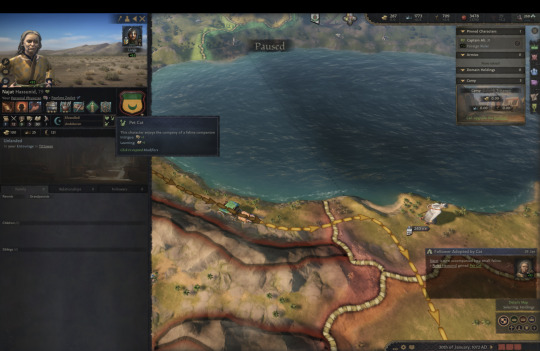
El Cid moves his Camp from the southern tip of Iberia which is Tarifa to Muluya in North Africa in order to collect his Roll of Patron Request from Wali Qasim. Along the way whilst traveling, his Personal Physician Najat Hassunid gets adopted by a Pet Cat.
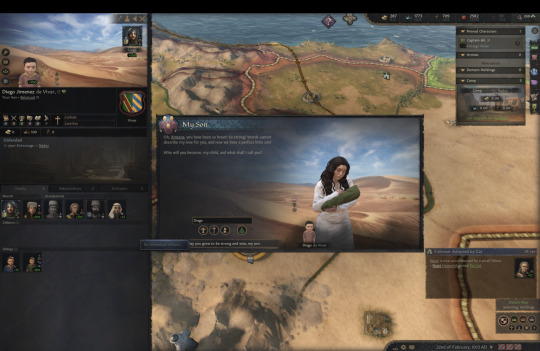
In the meantime in the desert, Mistress Ximena gives birth to El Cid's 2nd son - Diego Jimenez de Vivar.
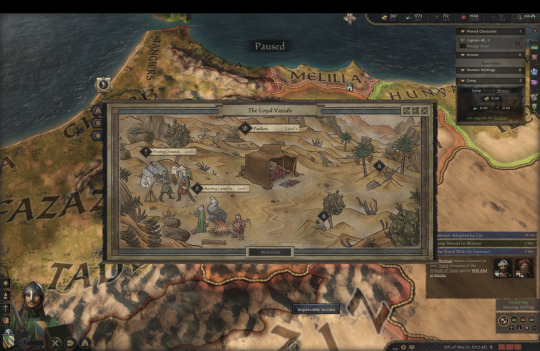
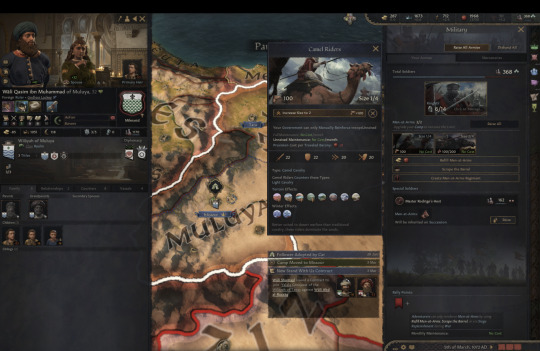
Having moved to Muluya, there's a change in the terrain scenery from that of green lush vegetation to a dry desert landscape with prickly cacti. Wali Qasim of Muluya grants El Cid a unit of Camel Riders which are regional to North Africa as a bonus reward for a job well done defending Muluya.



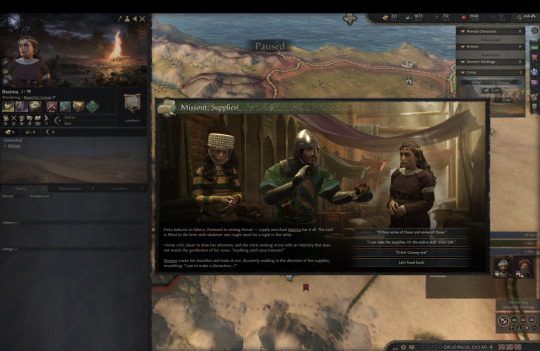
El Cid enters Missour Castle in Muluya with his wife Ximena exploring the place thoroughly.
Firstly, at the Training Grounds El Cid recruits the local Master of Arms to become his Master of Arms - a Butr man by the name of Tahir who is Homely but Robust. Next, at the tavern he follows a wanted criminal called Maziba down a stairwell into the cellar, but does not have enough gold to recruit him. At the merchants' stalls, El Cid sells off his Quail's Eggshell "Gem" for a higher price at 17 gold and then intimidates the supply merchant for a free 400 provisions.
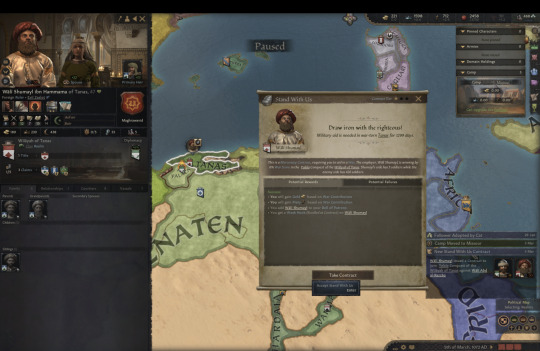
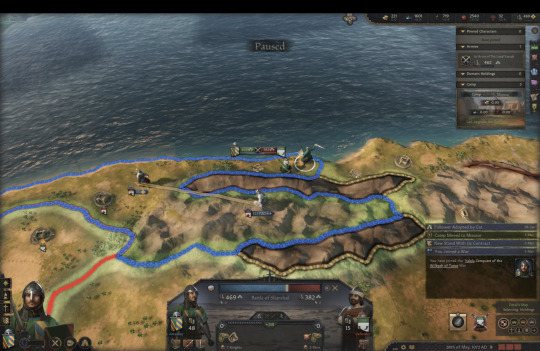
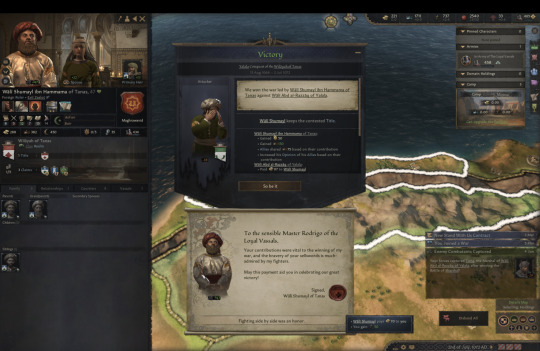
Scouring the lands of North Africa, El Cid comes across a mercenary contract for Wali Shumayl ibn Hammama of Tanas requiring military aid to defend against neighbouring Yalala. El Cid quickly joins and defeats the enemy at the Battle of Sharshal with his Camel Riders and Caballeros. Not long after, Wali Shumayl wins the war and pays El Cid 70 gold for his efforts.


El Cid makes a calculated move to Tanas, having impressed Wali Shumayl and wanting to collect his due Patron Request from the Wali. During the move, his Second and Best Friend Alvar gets into a scuffle with Agahli "the Heathen", to which El Cid intervenes before it gets out of hand.

The Loyal Vassals' Pavilion gets upgraded to level 2, and the surrounding terrain changes as well to a mountainous region with sparse trees and rocks.

Arriving in Tanas, El Cid's first order of business is to go fishing. He rents a small boat and bags a large mackerel which gives him 200+ Provisions.
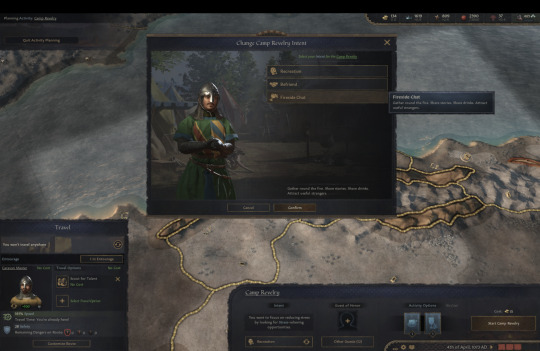

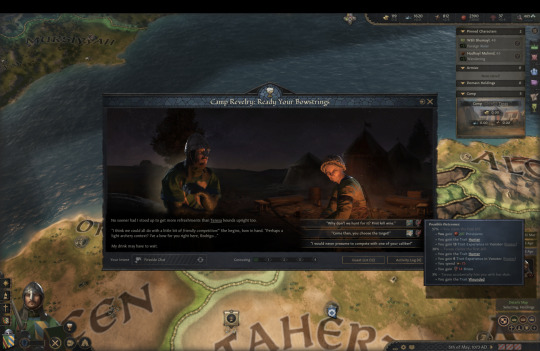
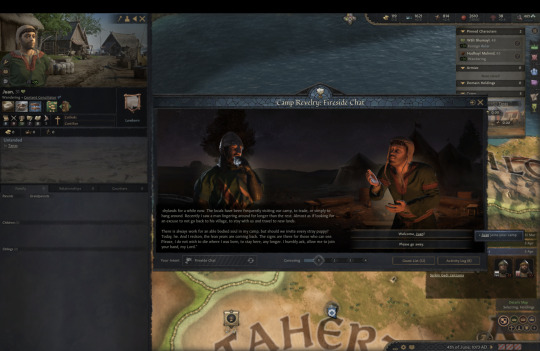

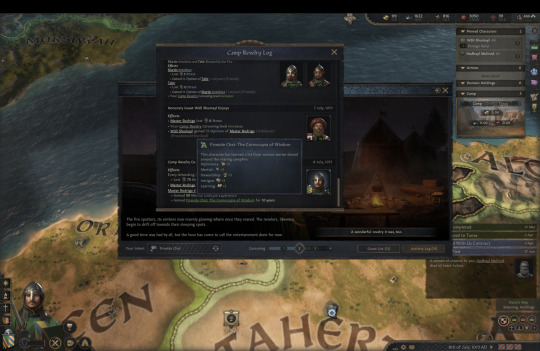
Next, El Cid holds a Camp Revelry for his followers and the Guest-of-Honor Wali Shumayl of Tanas. The Fireside Chat attracts 2 more followers to the Camp: Juan, the Shrewd Castilian who seems oddly out-of-place in Tanas, and T'awes Jalayar, a Slow Giantess of immense strength and fighting ability.
#ck3#crusader kings iii#crusader kings 3#el cid#rodrigo the campeador#roads to power#landless adventurer
2 notes
·
View notes
Text
Fifth day of Christmas journal prompts - Festive traditions
Tradition Time Travel: If you could experience one Christmas tradition from any era, past or future, what would it be, and why?
Signature Sips: Dive into the holiday drink traditions. What's your go-to festive beverage, and does it come with any special rituals or memories?
The Decor Dance: Describe your family's unique approach to decorating for Christmas. Any quirky traditions or epic debates about tinsel placement?
Santa's Workshop: If you were in charge of creating a new Christmas tradition for families around the world, what would it be, and how would it spread joy?
Ugly Sweater Soirée: Share your craziest or most memorable ugly sweater party experience. What made your outfit stand out or led to some unforgettable moments?
Tree Trimming Tales: Reflect on the process of picking out and decorating the Christmas tree. Any funny stories or particular ornaments that steal the show?
The Christmas Countdown: Explore the various ways you've counted down to Christmas over the years. Advent calendars, chains, or perhaps a creative twist of your own?
Culinary Customs: Delve into the delicious side of traditions. What recipes or dishes define your family's Christmas feast, and are there any secret ingredients or special techniques?
Generosity Games: Did your family have any unique ways of giving back during the holiday season? Share stories of charitable traditions or random acts of kindness.
The Annual Movie Marathon: Break down your must-watch Christmas movie list. Any specific order, themed snacks, or heated debates over the best version of a classic?
Fireside Frolics: If your fireplace could tell stories from your Christmas gatherings, what tales would it share? Cozy chats, marshmallow roasts, or maybe even a Santa sighting?
Letters to Santa: Reflect on the evolution of your letters to Santa over the years. Any outrageous requests or heartfelt messages that still make you smile?
Neighborhood Noel: Share memories of your community's Christmas spirit. Did you have any traditions that involved neighbors or local festivities?
Christmas Card Chronicles: Describe your family's approach to sending Christmas cards. Do you go for the classic family photo or opt for a more creative and quirky vibe?
The Gift-Giving Game: Explore your family's approach to gift-giving. Any unique traditions, like scavenger hunts or themed presents, that make the exchange extra special?
Caroling Chronicles: Did your family ever go caroling or have carolers visit? Share your experiences, whether they involved pitch-perfect performances or hilarious off-key renditions.
The Christmas Eve Extravaganza: Dive into the details of your family's Christmas Eve traditions. Midnight Mass, festive feasts, or perhaps a wild game night – spill the Yuletide tea!
Memory Ornaments: Explore the stories behind your favorite Christmas ornaments. Do any hold special memories or symbolize specific moments in your life?
Tradition Transformation: Have any Christmas traditions evolved or changed over the years? How have you adapted to new circumstances while keeping the festive spirit alive?
Holiday Hobbies: Share any special hobbies or activities that are reserved specifically for the holiday season. Baking, crafting, or perhaps mastering the art of snowflake-making?
The Christmas Morning Rituals: Break down the steps of your Christmas morning routine. From the first wake-up call to the last present opened, what rituals make it uniquely yours?
Snow Day Spectacular: If you live in a snowy area, reflect on your favorite snow day traditions. Sledding, snowball fights, or building epic snow forts – what's your go-to snowy adventure?
Festive Fashion Fables: Dive into the fashion side of traditions. Are there specific outfits or accessories that have become synonymous with your holiday celebrations?
New Traditions Exploration: If you were to create a brand new Christmas tradition this year, what would it be, and how do you envision it becoming a beloved part of the season?
Tradition Throwback: Share a cherished tradition from your childhood that you would love to bring back or pass down to future generations.
The Unexpected Tradition: Reflect on a spontaneous or unexpected tradition that started organically. What made it special, and how did it become a repeat performance?
The Technology Twist: How has technology influenced your Christmas traditions? Do you have virtual celebrations, online gift exchanges, or festive Zoom calls with loved ones?
The Pet Parade: If your pets could talk, what tales would they tell of Christmas festivities? Any memorable moments involving tree-climbing cats or present-ripping pups?
Tradition Tune-Up: Explore the role of music in your family's traditions. Are there specific songs that are must-haves for certain activities or moments during the holidays?
The Tradition Legacy: Reflect on the traditions you hope to pass on to future generations. What values or experiences do you want your family to carry forward in the spirit of Christmas?
#journal prompts#journaling#journal#journals#12 days of christmas journaling#christmas journal prompts#christmas festivities#christmas traditions
3 notes
·
View notes
Text
They actually talked about this exact thing in the Worlds Beyond Number patreon fireside chat that came out today
Erika: That was also one of my favorite exchanges. Him [Lou] saying, "Oh yeah, detail is bad because Brennan is telling you what he's about to take away"
Aabria: I know that trick! That's a GM looking at another GM going like, "Okay, I see what we're doing here. Thank you for the inventory check. Fuck"
Brennan: Well that's the thing, right? Detail is always your deadliest weapon and your biggest give away. Aabria does it when you're considering an action, that's when I know she does it. She's like, "You get to a new town, what do you wanna do?" And you're like, "I wanna go to a tavern! I might treat some of the locals to a drink?" "What drink? What drink?"
Aabria: cackling
Brennan: And you're like, "I, I make an investigation- how many- what kind of drinks do they- I, no, I- No actually I don't drink it! No actually I go straight to bed! I stay on the ship! I don't do that! I don't do that!"
The thing that gets me about Aabria's dming style (or well. One of the things) is she seems so very nice. "Here, have inspiration. Of course you can add your magic die. You rolled a 6 on perception, okay well I'll still give you a little thing at least."
She's so nice and so friendly, she will yes and almost anything the players want to do.
And this is all very fun and nonthreatening and easy until suddenly she says yes to something a player does that they absolutely should not do. Until she says "you did this so now this happens" and sets the DC for not dying at 30. Oh but she's still nice! You can use your magic die! You can keep the magic motes from last time since it was a cliffhanger so you can use those too! It's totally possible!
Aabria will let you do anything. And you don't realise that that's not as "nice" as you think it is until it's too late
4K notes
·
View notes
Text
🚨 Stop Believing the AI Hype, that’s the title of my latest conversation on the Localization Fireside Chat with none other than @Dr. Sidney Shapiro, Assistant Professor at the @Dillon School of Business, University of Lethbridge. We dive deep into what AI can actually do, and more importantly, what it can’t. From vibe coders and synthetic data to the real-world consequences of over-trusting black-box models, this episode is packed with insights for anyone navigating the fast-moving AI space. 🧠 Dr. Shapiro brings an academic lens and real-world practicality to an often-hyped conversation. If you're building, deploying, or just curious about AI, this is a must-read. 🎥 catch the full interview on YouTube: 👉 https://youtu.be/wsqN0964neM Would love your thoughts, are we putting too much faith in AI? #LocalizationFiresideChat #AIethics #DataScience #AIstrategy #GenerativeAI #MachineLearning #CanadianTech #HigherEd #Localization #TranslationTechnology #Podcast
#AI and Academia#AI Ethics#AI for Business#AI Hype#AI in Canada#AI Myths#AI Strategy#Artificial Intelligence#Canadian Podcast#Canadian Tech#chatgpt#Data Analytics#Data Science#Dr. Sidney Shapiro#Explainable AI#Future of AI#Generative AI#Localization Fireside Chat#Machine Learning#Robin Ayoub#Synthetic Data#Technology Trends
0 notes
Text
youtube
SEO Fireside Chat (Part 10) Website SEO strategies can seem daunting, but with the right guidance, they become powerful tools to increase your online visibility and attract more targeted traffic to your business. KaeRae Education's simple walk-through demystifies these techniques, empowering you to understand and implement your own SEO strategies with confidence, ultimately helping your website climb search engine rankings and reach more potential customers. Get access to the full SEO Fireside Chat here: https://ift.tt/8pUb6Oj ✅ Important Links to Follow - Google Audit: https://ift.tt/N926b3o - Google Ads Management: https://ift.tt/VbT7XWc - SEO Website Update: https://ift.tt/4z5F8Us - Visit for digital resources: https://ift.tt/WvxDIZA - Join a free community: https://ift.tt/hKHIlLE 🔔𝐃𝐨𝐧'𝐭 𝐟𝐨𝐫𝐠𝐞𝐭 𝐭𝐨 𝐬𝐮𝐛𝐬𝐜𝐫𝐢𝐛𝐞 𝐭𝐨 𝐦𝐲 𝐜𝐡𝐚𝐧𝐧𝐞𝐥 𝐟𝐨𝐫 𝐦𝐨𝐫𝐞 𝐮𝐩𝐝𝐚𝐭𝐞𝐬. https://www.youtube.com/@kaeraemarketing/?sub_confirmation=1 🔗 Stay Connected With Me. Facebook: https://ift.tt/Ga4QvRM Instagram: https://ift.tt/Z7JdCQw Tiktok: https://ift.tt/HJzsWg7 Linkedin: https://ift.tt/0YBGcQO Pinterest: https://ift.tt/KbR1Uoc Website: https://ift.tt/ZMJzBn0 📩 For business inquiries: [email protected] ============================= 🎬Suggested videos for you: ▶️ https://youtu.be/8ld3_DuQqXg ▶️ https://youtu.be/XOYPpbh3zaY ▶️ https://youtu.be/mQJoodRwM84 ▶️ https://youtu.be/xex_HqP0QWU ▶️ https://youtu.be/p_x_ubfygfM ▶️ https://youtu.be/pFkiL4fh6o0 ▶️ https://youtu.be/00tcBgRxjAI ▶️ https://youtu.be/Lc-F8HzoyFY ▶️ https://youtu.be/poLpFGWBvFM ▶️ https://youtu.be/E8mUUvMsUmU ▶️ https://youtu.be/d-o5pv-HDFw ▶️ https://youtu.be/NTdbrijJKyM ▶️ https://youtu.be/I5sxI9RaHXY ================================= ✅ About Kelsey Flannery (KaeRae Marketing). Welcome! I’m Kelsey Flannery, also known as KaeRae, a Google Ads expert helping business owners navigate Google tools with ease. Through simple, informative videos, I provide guidance on Google Analytics, Google Ads, Google Business, Search Console, Tag Manager, YouTube Ads, Local Services Ads, Merchant Center, and more. As the owner of KaeRae Marketing, Inc., I provide results-driven marketing for home service businesses and eCommerce. Certified in key Google tools, I specialize in lead generation, PPC advertising, and online growth strategies. Let’s maximize your business’s online reach and drive real results! For Business inquiries, please use the contact information below: 📩 Email: [email protected] 🔔 Struggling with Google Analytics, Ads, or SEO? Subscribe for expert tips, effective strategies, & the best tools on PPC, lead generation, and maximizing your online reach! https://www.youtube.com/@kaeraemarketing/?sub_confirmation=1 ================================= 🔎 Related Phrases: SEO basics, keyword research, organic traffic, backlink building, on-page optimization, meta descriptions, title tags, content marketing, search engine rankings, SEO audit, link building strategies, Google algorithm updates, local SEO, mobile optimization, site speed optimization, voice search SEO, technical SEO, featured snippets, competitive analysis, search intent Hashtags #SEOBasics #KeywordResearch #OrganicTraffic #BacklinkBuilding #OnPageOptimization #MetaDescriptions #TitleTags #ContentMarketing #SearchEngineRankings #SEOAudit #LinkBuildingStrategies #GoogleAlgorithmUpdates #LocalSEO #MobileOptimization #SiteSpeedOptimization #VoiceSearchSEO #TechnicalSEO #FeaturedSnippets #CompetitiveAnalysis #SearchIntent via Kelsey Flannery (KaeRae Marketing) https://www.youtube.com/channel/UCji8NuY6sx7RVYD85k_XJlQ May 24, 2025 at 01:00AM
#googleads#googleadwords#digitalads#ppcadvertising#digitalmarketing#businessgrowth#keywordsresearch#googlebusiness#Youtube
0 notes
Text
I’m mostly with you but I want to push back on this. Because he’s NOT wrong. Every time Kamala opens her mouth she sounds scripted (with her rare, memeable moments being the exception.) because she has made her career being prepared to speak in court.
Every generation a candidate comes along who, no matter their politics is just an absolute master of a new medium. Roosevelt had his fireside chats, it made people feel that he was sitting in their living rooms, talking to them specifically. Reagan was a master of the soundbite and well-delivered line that played well on the nightly news, Trump is a master of the current medium, social media. He tweets “Covfefe”, and we all make fun of it, but it shows he’s NOT polished. He blunders, and rambles and tweets stupid shit. But he doesn’t even get embarrassed or apologize. He just keep plucking along to his next horrifying idea. It’s not okay, but it’s sure fuckin relatable.
Now he’s possibly a candidate for the worst human being alive this century, with a handful of ethnic cleansers, and absolute despots ahead of him, but it’s neck and neck.
But one thing the left NEEDS is a straight-talker who is willing to put full transparency online. Someone who pisses off their own publicity team for speaking off the cuff. Someone whose heart is in the right place even if their foot is in their mouth half the time. And if we find that person, the rest of the left and liberal electorate need to stop being the etiquette police, and focus on getting shit done in our school boards, local elections, and state governments.
“An Arizona man, citing the time Harris said, “you better thank a union member,” during a speech in Detroit, said “that was very disingenuous to me because I didn’t see an honest person that could be president.” “It seemed like a lot of what she came out and said wasn’t really off-the-cuff, wasn’t coming from her,” said another man who voted for Biden in 2020 and Trump in 2024. “Seemed like every interview, every time she came out and talked about something, it was planned out and never her thoughts, didn’t seem genuine to her thoughts, whereas, Trump, even though you never really knew what he was going to say, when he was going to say it, it was always him and genuine to what he thought, so that’s what swayed me.””
—
New research shows the massive hole Dems are in
I mean … I don’t know how anyone worth electing is going to reach someone like this guy who basically says he’d rather vote for someone who rambles incoherently, with a clear track record of violence and corruption, because he didn’t like the way the scary Black lady talked.
Why is this guy even in this article? This guy is a lost cause. This guy is not the Democrats’ fault. This guy is a stupid fucking idiot who shouldn’t be allowed to be alone in any room with a sharp object.
And this is the guy the Democrats are going to throw the trans community under the bus for, the guy who says he didn’t like how prepared and articulate Kamala Harris was when she expressed her positions, when what we all know is that he didn’t like that she was a Black woman.
THAT is the real disgrace and failure of the party: chasing this guy at the expense of ten people who want to vote for them, because they listen to dipshit consultants who have lost all but two consequential elections for the last twenty years.
775 notes
·
View notes
Text
How Guindy Coworking Spaces Help You Scale

In the ever-evolving startup landscape of Chennai, one locality stands out as a powerful launchpad for small businesses—Guindy. Known for its strategic location, vibrant commercial environment, and growing innovation ecosystem, Guindy has become a hotspot for coworking spaces that support businesses at every stage.
If you’re a small business owner or budding entrepreneur looking to scale operations without being tied down by traditional office costs and limitations, choosing a coworking space in Guindy might be your smartest decision in 2025.
🌍 Why Guindy Is a Magnet for Growing Businesses
Guindy has transformed from an industrial suburb to one of Chennai’s most sought-after business districts. Its evolution has been fueled by its connectivity, affordability, and access to top talent. Here's what makes Guindy so ideal for startups and SMEs:
Close to key locations like the airport, metro stations, and major IT parks
Easy access to arterial roads including GST Road and Mount Road
Presence of business parks like Olympia Tech Park and DLF Cybercity
Affordable commercial real estate compared to areas like Nungambakkam or Teynampet
Nearby amenities such as hotels, restaurants, banks, and hospitals
Whether you’re scaling your operations, building a hybrid team, or entering a new market, Guindy provides an ecosystem that helps small businesses punch above their weight.
🚀 Lower Overheads, Higher Focus on Growth
The biggest benefit of working from a shared office is the elimination of upfront costs. Traditional commercial leasing often requires large deposits, long lock-in periods, and investment in infrastructure. On the other hand, coworking solutions allow businesses to:
Start with flexible monthly plans instead of long-term commitments
Avoid the hassle of purchasing desks, chairs, or setting up internet
Pay only for what they use—be it meeting rooms, private cabins, or common areas
By reducing operational overhead, businesses free up capital that can be invested in marketing, hiring, or product development.
📈 Scale Without Relocating
In early stages, it’s hard to predict how quickly a business might grow. Coworking operators understand this need for agility. As a result, most offer:
Hot desks for freelancers and consultants
Dedicated desks for small teams
Private cabins for fast-growing startups
Custom suites for mid-sized enterprises
The best part? You can scale from a two-seat setup to a 20-seat private office without changing buildings or postal addresses—saving you time and money.
🧑💼 Build Connections That Fuel Growth
One of the most underappreciated advantages of coworking is the organic networking it enables. Sharing a space with professionals from different domains fosters daily interactions that can lead to:
Strategic collaborations with marketing agencies, developers, or consultants
Client referrals from fellow entrepreneurs
Mentorship and advice from seasoned founders
Event-based networking through startup showcases, fireside chats, or workshops
Being part of a thriving business community can open up opportunities you might never find sitting in a traditional office.
📍 Strategic Location Adds Credibility
Having a commercial address in Guindy boosts your business's credibility. It communicates professionalism to clients, vendors, and potential partners. Many shared offices in this locality are housed in landmark buildings like:
Olympia Tech Park
DLF IT Park
Prestige Polygon
Being based in such environments means your clients take you more seriously—and that helps when pitching for funding or negotiating contracts.
⚙️ Access to Built-In Admin Support
Another reason why small businesses flourish in coworking spaces is the availability of backend support. Rather than hiring full-time admin staff, businesses benefit from:
Front desk and reception services
Mail and courier handling
Meeting room booking systems
On-site tech support and housekeeping
These value-added services take away the headache of managing an office, letting you focus solely on building your business.
🌐 Hybrid Work Ready
Today’s teams often work across cities—or even countries. The best coworking providers in Guindy offer solutions that cater to this hybrid working model:
Virtual office plans for businesses operating remotely
Day passes and hot desks for traveling employees
Video conferencing rooms for remote client presentations
24/7 access for those working different time zones
This flexibility makes it easier to grow and manage distributed teams.
📊 Built for Productivity
Productivity can often be a challenge when working from home or a café. Shared work environments are designed to help teams stay focused and motivated. Features often include:
Ergonomic seating and natural lighting
Quiet zones for deep work
Brainstorming rooms with whiteboards
Fast, reliable internet with backups
By creating a distraction-free atmosphere, these offices help you get more done in less time.
💼 Support Beyond the Desk
Some coworking operators go beyond physical space and offer value-added services tailored for small businesses. These can include:
Legal, HR, and accounting help through partner networks
Business acceleration programs
Investor meetups and pitch sessions
Access to startup communities and job boards
This support infrastructure can play a pivotal role in taking your business to the next level.
🏢 Names Worth Considering in Guindy
Here are a few shared offices in Guindy that are especially suitable for small businesses:
Smartworks – Ideal for early-stage tech startups
Regus – Suitable for professionals seeking a global feel
Workafella – Offers excellent amenities and community engagement
The Hive – Great for creatives and design-centric teams
DLF Flexi Office – Known for prime location and flexible plans
Each of these offers a unique vibe, so it’s best to visit and try out a day pass before committing.
🔍 What to Ask Before Choosing a Space
When evaluating your options, consider these questions:
Is the location convenient for your team and clients?
Are there plans that let you scale easily?
What support services are included?
Is there sufficient parking and connectivity?
Do they host networking or learning events?
Choosing the right shared office is more than just about price—it’s about fit, flexibility, and future-readiness.
💬 Real Startup Stories from Guindy
Vidya P., founder of a boutique design studio: “Starting from a small desk, we doubled our team in 6 months without relocating—just upgraded our plan.”
Rajan K., a tech entrepreneur: “Being in a coworking hub helped us meet partners, hire interns, and even find our first investor.”
Meena and Ravi, e-commerce founders: “We saved lakhs in setup cost and were operational in two days. That speed helped us hit the market before our competitors.”
🔚 Final Takeaway
Small businesses thrive when they’re in environments that promote flexibility, affordability, and innovation. That’s exactly what Guindy’s coworking ecosystem offers. With easy access, smart infrastructure, and a collaborative atmosphere, it creates the perfect launchpad for business growth.
So, if you're ready to scale smartly, consider exploring your options in this buzzing locality—it could be the catalyst your business needs in 2025.
0 notes